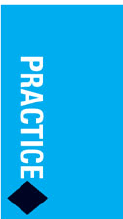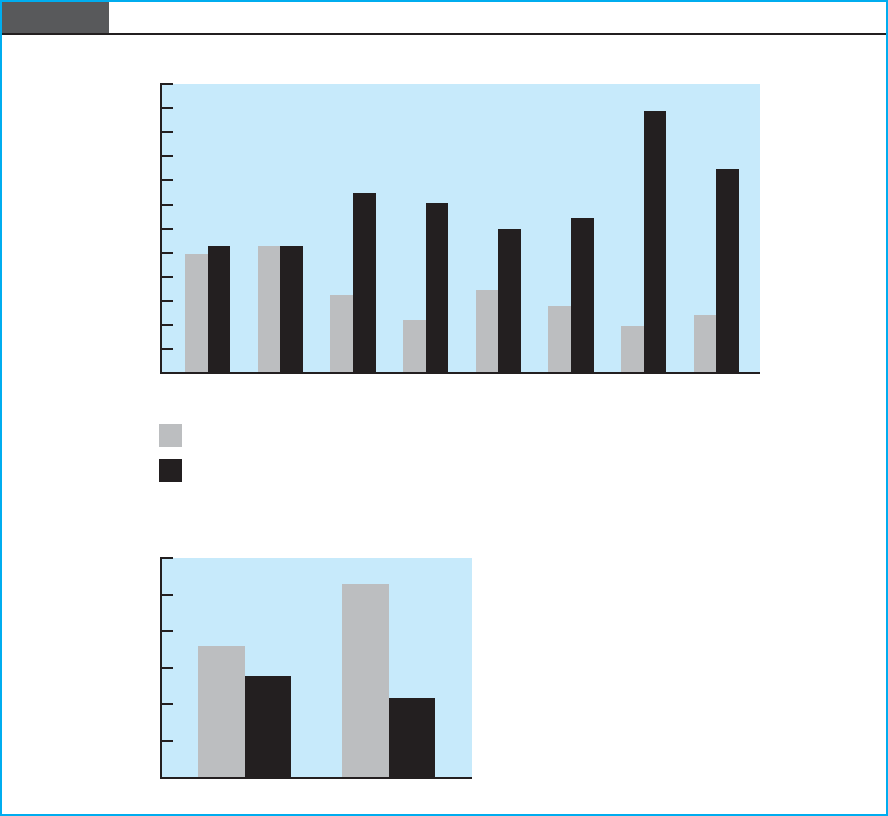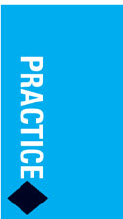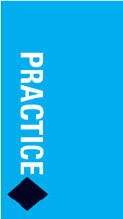Whetten David A., Cameron Kim S. Developing management skills
Подождите немного. Документ загружается.


MAKING ORAL AND WRITTEN PRESENTATIONS SUPPLEMENT A 607
broaden the discussion. Don’t get trapped into an argu-
ment with one person. Involve others to determine if
this is an isolated concern or a legitimate issue. Finally,
you might express your willingness to discuss special or
detailed issues but defer extensive discussion until the
end of your presentation.
Summary and Behavioral Guidelines
A key aspect of management is communication, and
formal presentations are an essential communication
tool. Therefore, effective managers must be able to
create effective informative and persuasive messages.
You can enhance your speaking and writing with
thorough preparation and repeated practice. This chap-
ter has outlined a number of guidelines based on the
Five S’s model:
1. Formulate a strategy for the specific audience
and occasion.
2. Develop a clear structure.
3. Support your points with evidence adapted to
your audience.
4. Practice presenting your material in a style that
will enhance your ideas.
5. Supplement your presentation by effectively
responding to questions and challenges.
Strategy
1. Identify your general and specific purposes.
2. Tailor your message to your audience.
❏ Understand their needs, desires, knowledge
level, and attitude toward your topic.
❏ Make sure your approach is audience-
centered.
❏ Present both sides of the issue if your audience
is hostile or uncommitted.
3. Meet the demands of the situation.
❏ More formal situations demand formal
language and sentence structure.
❏ Informal situations allow slang and less rigid
language use.
Structure
4. Begin with a forecast of your main ideas.
❏ Catch your audience’s attention as you begin.
❏ Provide them with a reason for listening or
reading.
❏ Give them an outline of the message so they
can follow along.
5. Choose your organizational pattern carefully.
❏ Start with what your listeners already know or
think.
❏ Use organization to increase your credibility.
❏ Move from familiar to unfamiliar, simple to
complex, old to new, or use other continua for
organizing your thoughts.
❏ Make no more than three to five main points
in oral communication.
6. Use transitions to signal your progress.
7. Conclude on a high note.
❏ Take advantage of greater audience attention
at the conclusion of your message.
❏ Reach closure by reinforcing through a
summary of your ideas.
❏ Use your last statements to call for action,
reinforce the commitment to action, or
establish a feeling of goodwill.
Support
8. Choose a variety of support.
❏ The most effective support is not well known
to your listeners.
❏ Support increases your credibility.
❏ You may use a wide variety of supporting
material.
9. Consider your audience when choosing your
support.
❏ New evidence and live videotapes have more
impact.
❏ The audience’s initial position determines the
extent to which they find evidence believable.
❏ Using evidence is better than not using
evidence.
10. Use visual aids as support.
❏ Visual aids have a dramatic impact on
comprehension and retention.
❏ Visual aids also enhance persuasion.
❏ Keep visual aids simple and effective.
Style in Oral Communication
11. Prepare your notes.
❏ Remember, the crucial effect is
conversational style.
❏ Extemporaneous presentation requires limited
notes combined with frequent delivery
practice.
❏ Formal occasions demand precise wording
that requires a manuscript or memorized
speech.
12. Practice your presentation.
❏ Use distributed practice rather than massed
practice.
❏ Practice using your visual aids and plan for
the unexpected.
❏ Plan to channel your speaking anxiety.
13. Convey controlled enthusiasm for your subject.
❏ Effective speakers communicate excitement
about their topics.
❏ Your posture, tone of voice, and facial
expressions all indicate your attitude.
❏ Your speech should resemble an animated
conversation.
14. Engage your audience with effective delivery.
❏ Eye contact is the most critical tool.
❏ Use physical space and body movement to
enliven your message.
❏ Use space to convey intimacy or distance.
❏ Use gestures to accentuate your normal mode
of expression.
❏ Avoid any movement that distracts from
your message.
Style in Written Communication
15. Develop mechanical precision in your writing.
❏ Project a professional image.
❏ Errors may distract your readers and disrupt
the impact of your message.
16. Practice factual precision in your writing.
❏ Accuracy ensures your meaning will be
communicated clearly.
❏ Ambiguity prevents factual precision.
17. Construct written messages with verbal
precision.
❏ Words cannot replicate reality.
❏ Consider denotative and connotative meanings
of words as you write them.
❏ The key to verbal precision is clarity.
608
SUPPLEMENT A MAKING ORAL AND WRITTEN PRESENTATIONS
18. Pay attention to tone.
❏ Tone is directly related to word choice.
❏ Adjust the tone of your message to the
formality of the situation.
❏ Tone affects how readers feel about the writer.
❏ Writing should express appropriate cordiality.
❏ Positive phrasing is preferable to negativity.
19. Use the proper format.
❏ You are responsible for creating an impression
of professionalism.
❏ Business letters, memos, and proposals all
have special formats.
Supplement: Questions and Answers
20. Anticipate questions and thoroughly prepare
responses.
❏ Rehearse answers to difficult questions.
❏ Handle hostile listeners with honesty and
directness.
21. Respond to objections in an orderly fashion.
❏ Restate the objection.
❏ State your position.
❏ Offer support for your position.
❏ Indicate the significance of your rebuttal.
22. Maintain control of the situation.
❏ Balance the demands of specific individuals
with the interest of the group.
❏ Keep exchanges on an intellectual level.
❏ Plan for the questioner who has a personal
agenda.

MAKING ORAL AND WRITTEN PRESENTATIONS SUPPLEMENT A 609
SKILL
PRACTICE
EXERCISES FOR MAKING EFFECTIVE
ORAL AND WRITTEN PRESENTATIONS
Speaking as a Leader
As illustrated in the opening case about Taylor Billingsley at Apex Communications, one of
the major challenges facing leaders is the requirement to deliver a wide range of pre-
sentations. Effective communicators must be skilled at both informing and inspiring. They
must be able to hold their own with hostile audiences as well as to impress content experts
and instill confidence in novices. They must be skilled at building consensus, pointing out
new directions, and explaining complex topics. This exercise, adapted from Richard
Linowes, provides an opportunity to practice speaking on a variety of leadership topics.
Assignment
To practice playing this important leadership role, prepare a talk and a memo on one of
the following topics. Your speech should last from three to five minutes, unless you are
otherwise instructed. Your memo should not exceed two pages. Create a context for your
communication by assuming a management role in a familiar organization. Before begin-
ning, explain the details of the context to your audience (either orally or in a written
summary). Briefly explain your organizational position, the makeup of the audience, and
their expectations of your presentation. (For the memo, attach a one-page background
statement.) The specific content of your communication is less important than how
well it is prepared and how persuasively it is delivered. Prepare to respond to questions
and challenges.
In preparing your presentation, review the behavioral guidelines at the end of the
Skill Learning section. The checklist in this exercise may also be useful. You will receive
feedback based on the criteria shown in the Observer’s Feedback Form.
Topics for Leadership Talks
1. Taking Charge of an Established Group. The speaker is a manager newly
assigned to a group that has worked together under other managers for some time.
2. Announcing a New Project. The speaker is announcing a new undertaking to
members of his or her department and is calling on all to rally behind the effort.
3. Calling for Better Customer Service. The speaker is motivating all employees
to be as attentive and responsive as possible to customers.
4. Calling for Excellence and High-Quality Work. The speaker is motivating all
employees to perform their jobs with a commitment to meeting the highest possible
standards.
5. Announcing the Need for Cost Reductions. The speaker is requesting everyone
look for ways to cut expenditures and immediately begin to slash spending.
6. Commending a Job Well Done. The speaker is extolling a group of people who
have worked very hard for an extended period to produce outstanding results.
7. Calming a Frightened Group of People. The speaker is endeavoring to restore
calm and confidence to those who feel panic in the face of distressing business
developments.
8. Addressing a Challenging Opposition. The speaker is presenting a heartfelt
belief to a critical, even hostile, audience.
9. Mediating Between Opposing Parties. The speaker is serving as judge or
arbiter between two groups who are bitterly opposed on a key issue.
10. Taking Responsibility for Error. The speaker is a spokesperson for an institution
whose actions have produced an unfortunate result that affects the audience.
11. Reprimanding Unacceptable Behavior. The speaker is rebuffing certain indi-
viduals who have failed to perform up to required levels.
12. Petitioning for Special Allowances. The speaker is presenting the case for an
institution seeking certain rights that must be authorized by some external body.
Checklist for Developing Effective Presentations
1. What are my general and specific objectives?
2. What is the context of my communication? (My audience, the situation, etc.)
3. How will I open and close the communication?
4. How will I organize my information?
5. How will I get and keep the attention of my audience?
6. What supporting materials will I use?
7. What visual aids (graphs, charts, objects, etc.) will I use?
8. How will I tailor the presentation to my audience?
9. What format will I use in my presentation?
10. What questions or responses will likely occur?
Quality Circles at Battle Creek Foods
A management tool made popular in Japan is widely used in U.S. firms. Ironically, Edward
Deming, an American, first brought the notion of “statistical quality control,” a manage-
ment tool, to the Japanese in the early post-World War II years. The Japanese combined
these ideas with the assumption the person who performs a job is the one who best knows
how to identify and correct its problems. As a result, the Japanese, with Deming’s help,
developed the “quality circle.” A quality circle is a group of people (usually about 10) who
meet periodically to discuss and develop solutions to problems related to quality, produc-
tivity, or product cost.
The purpose of this exercise is to give you an opportunity to make a presentation on
this important topic.
Assignment
You are the director of personnel at Battle Creek Foods, a leading manufacturer of break-
fast cereal. Productivity has been sagging industrywide, and your organization is starting
to see its effect on profitability. In response, you have been asked by the corporate execu-
tive committee to make a 20-minute oral presentation (or prepare a five-page memo) on
quality circles. The committee has heard that QCs have been initiated at several plants by
your leading competitor, and it would like your recommendation as to whether Battle
Creek Foods should follow suit. The committee’s only previous exposure to QCs is what
each member has read in the popular press. Using the following reference material,
prepare a presentation on quality circles. Explain the QC structure and process, and
the advantages and disadvantages of QCs. The final section of the presentation should
include a recommendation regarding their adoption at your plants. Prepare to respond to
questions and challenges.
610
SUPPLEMENT A MAKING ORAL AND WRITTEN PRESENTATIONS

MAKING ORAL AND WRITTEN PRESENTATIONS SUPPLEMENT A 611
In preparing your presentation, refer to the behavioral guidelines for effective pre-
sentations at the end of the Skill Learning section and the checklist in the preceding exer-
cise. You will receive feedback based on the Observer’s Feedback Form.
A Look at Some of the Evidence
Quality circles, on balance, appear to be making a positive contribution to product quality,
profits, morale, and even improved employee attendance (DuBrin, 1985, pp. 174–185).
The widespread attention QCs have received in recent years has led logically to their eval-
uation by both businesspeople and researchers. Here we will rely on several types of
evaluation methods, sampling first the positive evidence, and then the negative.
Favorable Outcomes with QCs
Honeywell, a high-technology electronics firm, has become a pioneer in the application of
QCs in North America. Honeywell currently operates several hundred QCs in the United
States. Typically, about a half-dozen assembly workers are brought together every two
weeks by a first-level supervisor or team leader. “We feel this type of participatory man-
agement program not only increases productivity,” says Joseph Riordan, director of
Honeywell Corporate Productivity Services, “but it also upgrades the quality of work life
for employees. Line workers feel they are more a part of the action. As a result, we find
the quality of work improves and absenteeism is reduced. With this kind of involvement,
we have, in many cases, been able to increase the capacity of a line without the addition
of tooling or extra shifts.”
Honeywell used the quality circle method to manage the problem of winning a renew-
able bid for a government contract. “Here was a situation,” Riordan relates, “where we
already had cut our rejects down, where all of the learning had effectively gone out of the
process.” The problem was assigned to the quality circle representing that particular work
area. “They came up with a suggestion for further automating the process that enabled us
to improve our competitive position by about 20 percent and win the contract.”
In an attempt to determine the appropriateness of QCs to North American firms, a
team of researchers set up a one-year field experiment at a metal fabricating facility of an
electronics firm.
Eleven quality circles, averaging nine production employees each, were established.
Performance was measured by a computerized monitoring system created from the com-
pany’s existing employee performance reporting system. Both quantity and quality
measurements were taken. Employee attitudes were also assessed, using the Motivating
Potential Score (MPS) of the Hackman-Oldham Job Diagnostic Survey.
The major result of the circle program was its positive impact on reject rate, as
shown in the top half of Figure A.3. Reject rates per capita for quality circle participants
dropped by one-third to one-half of the former rates by the time the program had run
three months. Surprisingly, the reject rates for the control group increased during the
same period.
An explanation offered by the researchers for these results is circle members tack-
led the issues of internal communication as a top priority item. For example, one of
the initial projects implemented by the QCs was improving training manuals and pro-
cedures, including translating materials into a worker’s native language if the worker
desired. Careful attention to better training in fundamentals prevented many errors.
Circle members also made fewer errors. In addition, the defective parts the circle
members did make tended to be less expensive to scrap or rework into usable parts.
The explanation given for these results is circle training instructs employees how to
prioritize problems on the basis of dollar impact on the company. The cost savings

generated by the lower reject rate represented a 300 percent return on the cost of
investment in the program.
The impact of QCs on participants’ level of work satisfaction was equally impressive.
Results shown in Figure A.3 indicate the Motivating Potential Score (MPS) for the circle
participants increased, while the control group showed a decrease. No other changes
were present in the work environment that would impact the experimental group differ-
ently than the control group. The researchers therefore concluded the improvement in
employee job attitudes could be attributed to the circle training program and the problem-
solving activity. The job characteristic most influenced by the quality activity was skill
variety: the extent to which a job requires a variety of skills.
Negative Outcomes with Quality Circles
Despite the favorable outcomes reported, many negative results have also been reported.
A review of the results of the first surge of QC activity in the United States revealed as
many as 75 percent of initially successful programs were no longer in operation after a
few years. Even Lockheed, one of the American pioneers in this method, had decreased
612
SUPPLEMENT A MAKING ORAL AND WRITTEN PRESENTATIONS
REJECT QUANTITY PER CAPITA
240
220
200
180
160
140
120
100
80
60
40
20
0
June
Quality circles
Noncircles
July Aug. Sept. Oct. Nov. Dec. Jan.
JOB DIAGNOSTIC SURVEY MPS SCORE
110
105
100
95
90
85
80
First test Second test
Figure A.3 Impact of Quality Circles on Employee Performance and Attitudes

its involvement with quality circles. Robert Cole, a recognized authority on the Japanese
workforce, made these pessimistic remarks:
[The] fact is that the circles do not work very well in many Japanese companies.
Even in those plants recognized as having the best operating programs, man-
agement knows that perhaps only one-third of the circles are working well, with
another third borderline, and one-third simply making no contribution at all. For
all of the rhetoric of voluntarism, in a number of companies the workers clearly
perceive circle activity as coercive. Japanese companies face a continuing strug-
gle to revitalize circle activity to ensure that it does not degenerate into
ritualistic behavior.
A study of quality circles in 29 companies, conducted by Matthew Goodfellow, found
only eight of them to be cost-effective in terms of gains in productivity. Management
consultant Woodruff Imberman investigated the 21 unsuccessful QC efforts and found four
major causes of failure. First, in many firms, the employees intensely disliked management.
Their antagonism carried over into the quality circles, which some employees perceived to be
a management ploy to reduce overtime and trim the workforce by increasing productivity.
Second, most organizations did a poor job of selling the QCs. Instead of conducting
individual discussions with employees, they relied on flip charts, booklets, and formal
management presentations. The workers were left wondering, “What’s in it for me?”
Third, the supervisors chosen to lead the circles received some training in human
relations and group dynamics, but they felt little of this information satisfied the specific
needs of their own departments.
Fourth, most of the 21 firms regarded the QC programs merely as a way of improv-
ing the efficiency of production techniques. They did not realize QCs cannot succeed
unless top management is willing to shift its philosophy toward emphasizing good rela-
tions among employees and between management and workforce. This last point hints
at the importance of establishing the conditions that allow a quality circle program to
succeed.
Key Elements of a Successful Program
Quality circle programs show some variation from company to company, whether these
companies are engaged in manufacturing or service. They may differ in how frequently
they meet, how much authority is granted to the team leader or supervisor, whether they
use a group facilitator in addition to a supervisor, and how much coordination there is
with the existing quality-control department. Based on the judgments of several
observers, the successful programs have certain elements in common.
Quality circles work best in firms where good employee-management relations already
exist. QCs are not likely to succeed in organizations suffering from acrimonious union-
management conflict or high levels of distrust between employees and management.
Top management is committed to the program. Without commitment from top manage-
ment, the initiation of a QC program is inadvisable. Instead, the director of a circle project
should first prepare reports on other companies where QCs have been successful and pre-
sent them to top management.
Circle leaders use a participative leadership style. Laurie Fitzgerald, a QC consultant,
advocates the “leader as a worker for the members” concept. When the circle leader takes
on a highly authoritarian role, the members are usually unresponsive.
The right people and the right area are selected. For quality circles to be effective, the
program manager has to be enthusiastic, persistent, and hardworking. The facilitator or
team leader must be energetic and cooperative. Also, another important step in getting
MAKING ORAL AND WRITTEN PRESENTATIONS SUPPLEMENT A 613
the program off the ground is to select an area of the company where one can expect
cooperation and enthusiasm from participants.
Program goals are stated explicitly. Objectives should be made clear in order to avoid
confusion or unreasonable expectations from the circle program. Among the goals of QC
programs are improving product quality, increasing productivity, improving communica-
tions between workers and supervisors, decreasing product costs, improving the quality
of work life, and preparing people for future supervisory assignments.
The program is well publicized throughout the firm. Once the program is started, infor-
mation about it should be disseminated widely throughout the company. Better commu-
nication results in less resistance and fewer negative rumors about the program. The con-
tent of the communication should be open and positive.
The program starts slowly and grows slowly. A gradual introduction of the program
helps expose people to new concepts and helps reduce doubts about its intention and
potential merit.
The QC program is customized to meet the needs of the firm. A subtle source of failure in
some QC programs is the use of a canned set of procedures that don’t fit local circum-
stances. A QC participant whose work is data processing may have difficulty with the trans-
lation of a case from the aerospace industry. A workable compromise is to use standard
training as a framework and build on it with the unique problems of the firm in question.
Quality circles are used as a method of employee development. A key purpose of these cir-
cles is to foster personal development of the participating workers. If managers intend to
install a QC as a tool for their own selfish gain, they would do better not to begin.
Management is willing to grant recognition for ideas originating in the circles. If man-
agement attempts to manipulate the circle volunteers or take away from them the credit
for improvements, the program will most likely backfire. More will be lost than gained.
Membership is voluntary. As with job enrichment and all forms of participative manage-
ment, employee preference is an influential factor. Employees who desire to contribute their
ideas will generally perform better than employees who are arbitrarily assigned to a QC.
Achievements of quality circles are recognized as results of group, not individual, effort.
Recognizing them as such decreases showing off and competitiveness and increases cooper-
ation and interdependence within the group or department. Quality circles, not individual
employees, should receive credit for innovations and suggestions for improvement.
Ample training is provided. Program volunteers generally need some training in confer-
ence techniques or group dynamics. At a minimum, the circle leader will need skills in
group participation methods. Otherwise, he or she will wind up lecturing about topics
such as quality improvement and productivity improvement. Leaders and participants
will also need training in the use of whatever statistical and problem-solving methods are
to be used. Following are eight major problem-solving techniques and their purposes:
1. Brainstorming is used to identify all problems, even those beyond the control of
circle members.
2. A check-sheet is used to log problems within the circle’s sphere of influence
within a certain time frame.
3. A Pareto chart graphically illustrates check-sheet data to identify the most serious
problems; that is, the 20 percent of the problems that cause 80 percent of the
major mistakes.
4. A cause-and-effect diagram graphically illustrates the cause of a particular problem.
614
SUPPLEMENT A MAKING ORAL AND WRITTEN PRESENTATIONS

5. Histograms or bar charts are graphed to show the frequency and magnitude of
specific problems.
6. Scatter diagrams or “measles charts” identify major defect locations, which show
up as dense dot clusters on the pictures of products.
7. Graph-and-control charts monitor a production process and are compared with
production samples.
8. Stratification, generally accomplished by inspecting the same products from
different production areas, randomizes the sampling process.
Creativity is encouraged. As illustrated above, brainstorming or variations thereof fit naturally
into the quality circle method and philosophy. Maintaining an attitude of “anything goes” is
particularly important, even if rough ideas must be refined later. If half-processed ideas are
shot down by the leader or other members, idea generation will extinguish quickly.
Projects are related to members’ actual job responsibilities. Quality circles are not arenas
for amateur speculation about other people’s work. People make suggestions about
improving the quality of work for which they are already responsible. They should, how-
ever, be willing to incorporate information from suppliers and customers.
The Arguments For and Against Quality Circles
A major argument for quality circles is they represent a low-cost, efficient vehicle for unleash-
ing the creative potential of employees. In the process, highly desirable ends are achieved,
such as improvements in the quality of both products and work life. Quality circles, in fact,
are considered part of the quality of work life movement.
Another favorable feature of these circles is they are perceived positively by all—
management, workers, unions, and stockholders. A firm contemplating implementing
such a program thus runs no risk of either internal or external opposition. (It is conceiv-
able, however, that opposition will be forthcoming if management fails to act on quality
circle suggestions.)
Quality circles contribute to organizational effectiveness in another important way.
They have emerged as a useful method of developing present and future managers.
Recently, a major computing manufacturing firm established a quality circle program.
After the program had been operating for two years, the director of training observed the
supervisors who were quality circle leaders were significantly more self-confident, knowl-
edgeable, and poised than other supervisors who were attending the regular training pro-
gram. The director believed the supervisors’ involvement in the QC training programs
and activities had been the major contributor to this difference.
One major criticism of quality circles is many of them are not cost-effective.
Furthermore, even more pessimistic is the criticism that the reported successes of QCs
may be attributable to factors other than the actual quality circle program. One explana-
tion is the attention paid to employees by management may be the force behind the gains
in productivity and morale (the well-known Hawthorne effect). Another possible expla-
nation of the successes of quality circle programs is the gains are due to improved group
dynamics and problem-solving techniques. Therefore, an entire QC program need not be
conducted just to achieve these gains.
A discouraging argument has been advanced that quality circles may not be suited to
North American workers. Matsushita Electric, a leading user of the quality circle method
in Japan, does not use circles in its U.S. plant (located in Chicago) because it does not
consider the American worker suited to circle activities. Perhaps Matsushita management
believes Americans are too self-oriented to be group oriented.
MAKING ORAL AND WRITTEN PRESENTATIONS SUPPLEMENT A 615
Quality circles may prove to be breeding grounds for friction and role confusion
between the quality-control department and the groups themselves. Unless manage-
ment carefully defines the relationship of quality circles vis-à-vis the quality-control
department, much duplication of effort (and therefore waste of resources) will
inevitably result.
Exclusive reliance upon volunteers for the circles may result in the loss of potentially
valuable ideas. Many nonassertive people may shy away from participation in the circles
despite their having valid ideas for product improvement.
Some employees who volunteer to join quality circles may do so for the wrong
reasons. The circle may develop the reputation of being “a good way to get away from the
line for a while and enjoy a coffee break and a good bull session.” (To counter such an
abuse of the quality-circle program, QC group members might monitor the quality of
input from their own group members.)
Guidelines for Action
An early strategic step in implementing a quality circle is to clarify relationships between
the circle and the formal quality-control department. Otherwise, the quality-control
department may perceive the circle as a redundancy or threat. One effective arrangement
is for the quality circle to complement the quality-control department; the QC depart-
ment thus does not become subject to the loss of authority.
Membership in the circle should be voluntary and on a rotating basis. In many
instances, a team member will soon run out of fresh ideas for quality improvement.
Rotating membership will result in a wider sampling of ideas being generated. Experience
suggests that group size should be limited to nine.
Quality circles should be implemented on a pilot basis. As the circle produces results
and wins the acceptance of managers and employees alike, it can be expanded as the
demand for its output increases.
Do not emphasize quick financial returns or productivity increases from the output of
the quality circles. The program should be seen as a long-range project that will raise the
quality consciousness of the organization. (Nevertheless, as noted in the report from
Honeywell, immediate positive results are often forthcoming.)
Management must make good use of many of the suggestions coming from the qual-
ity circle yet still define the limits of the power and authority of the circle. On the one
hand, if none of the circle’s suggestions are adopted, the circle will lose its effectiveness as
an agent for change. Circle members will become discouraged because of their lack of
clout. On the other hand, if the circle has too much power and authority, it will be seen
as a governing body for technical change. Under the latter circumstances, people may use
the circle for political purposes. An individual who wants to get a technical modification
authorized may try to influence a member of the quality circle to suggest modification
during a circle meeting.
Training in group dynamics and methods of participative management will be partic-
ularly helpful. It may also prove helpful at the outset to appoint a group facilitator (an
internal or external consultant) who can help the group run more smoothly.
616
SUPPLEMENT A MAKING ORAL AND WRITTEN PRESENTATIONS
